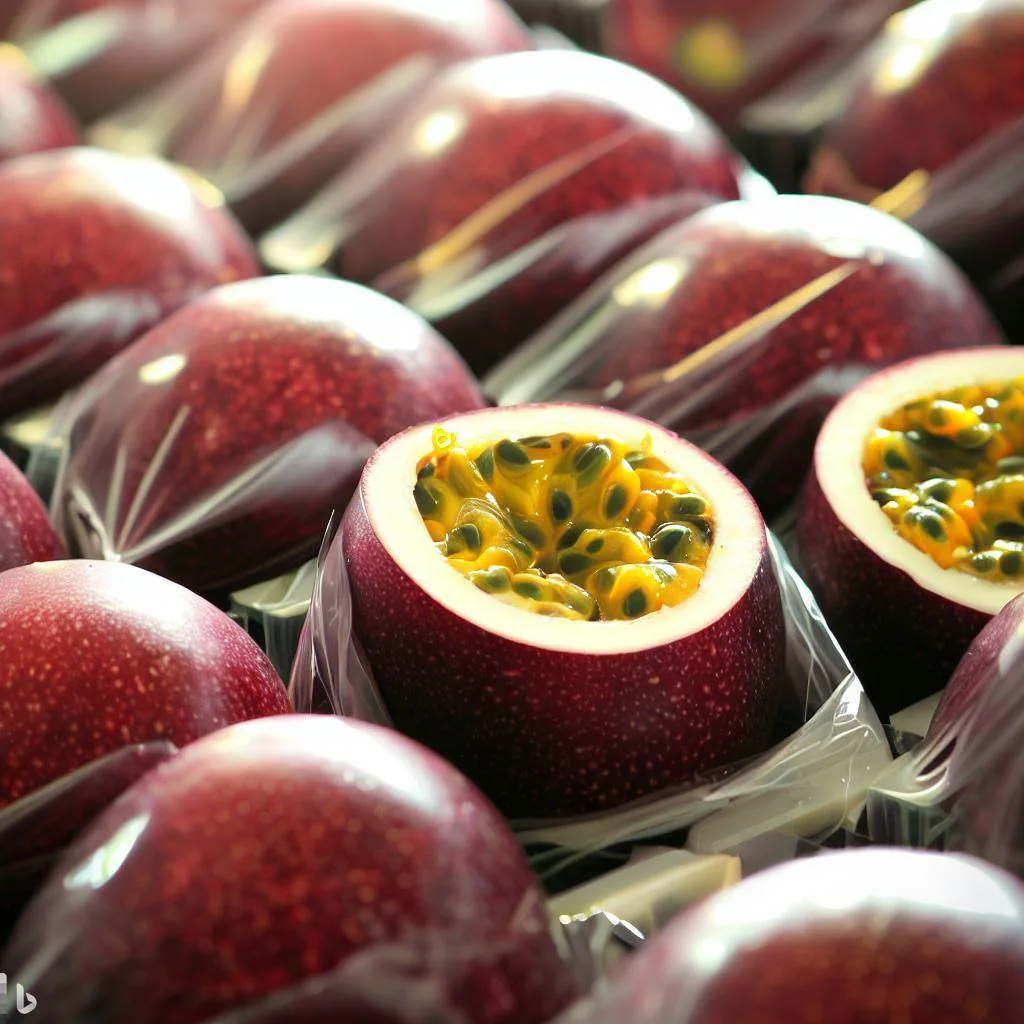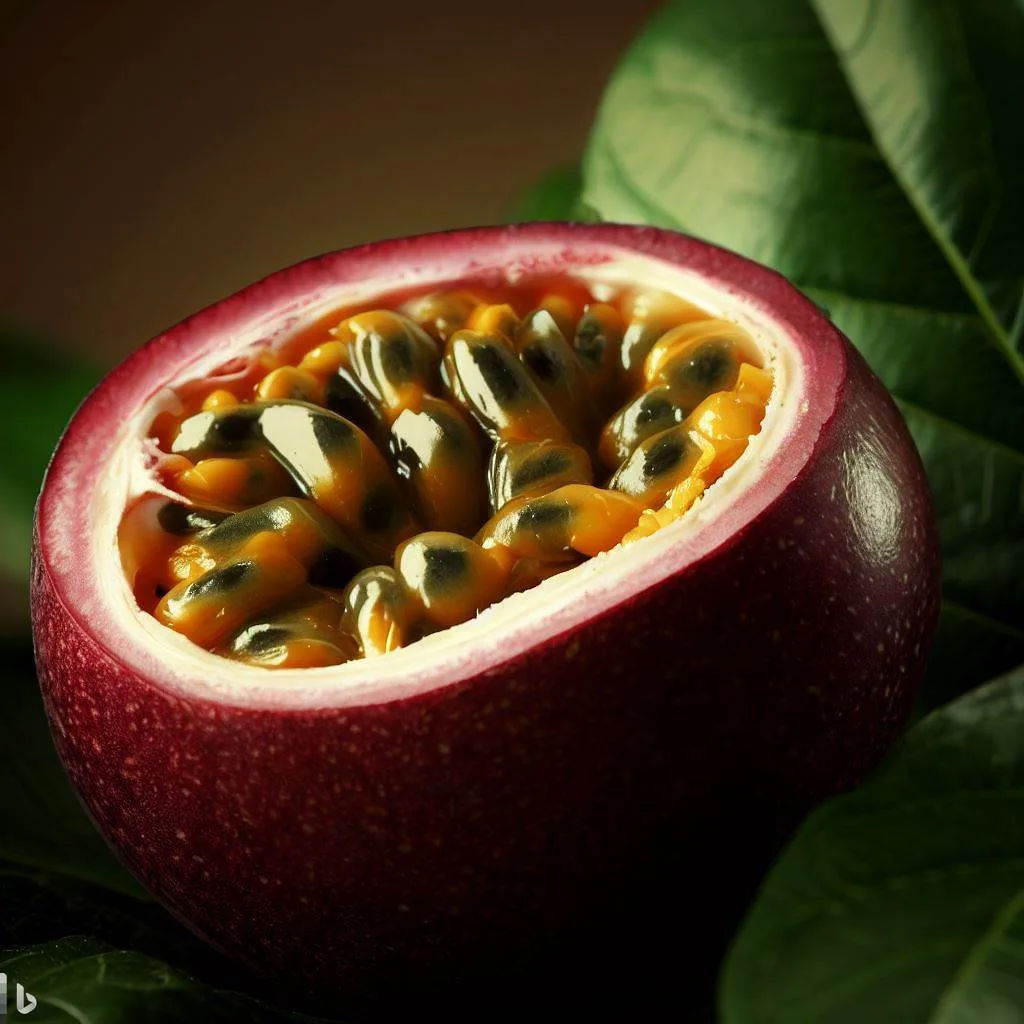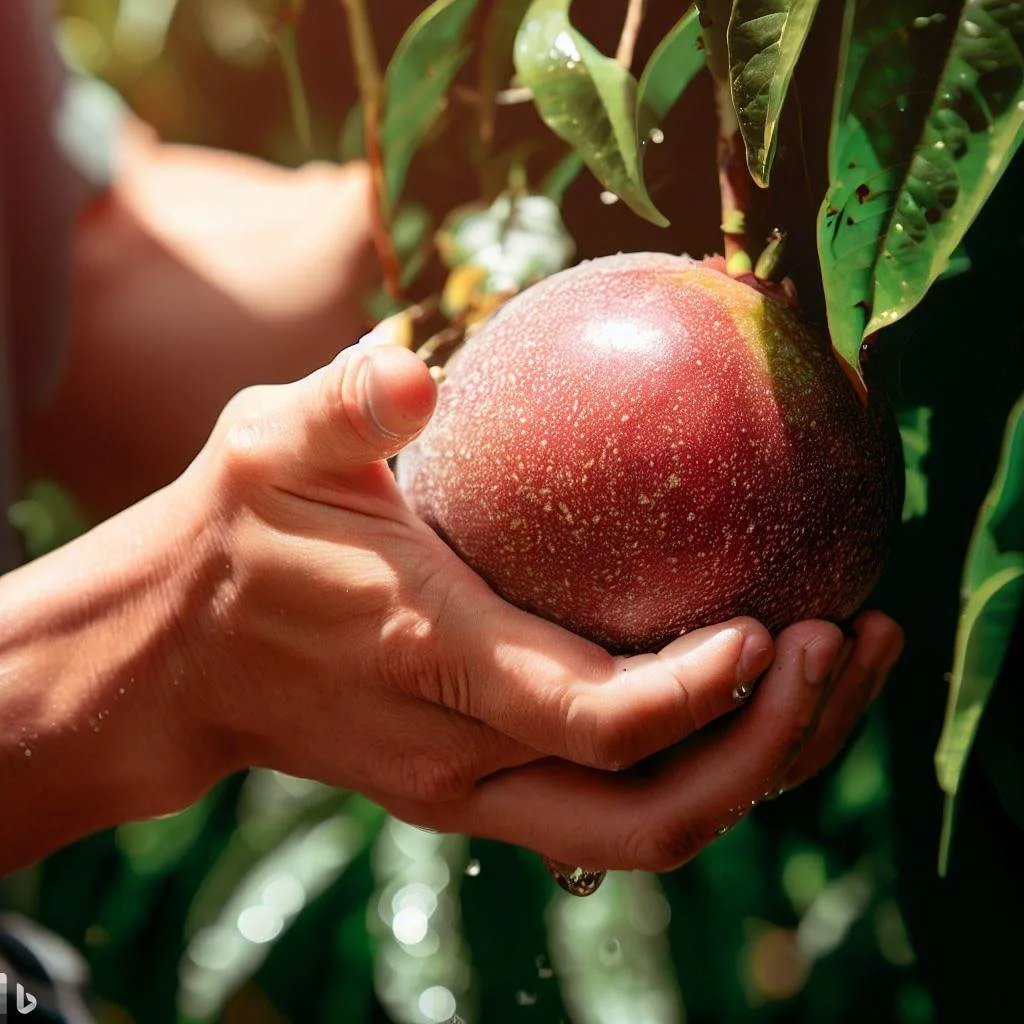Passion fruit is a tropical fruit that is popular for its unique taste, aroma, and nutritional benefits. It is a small, round fruit with a tough, outer rind that is purple or yellow in color, depending on the variety. The interior of the fruit contains a juicy, seed-filled pulp that is rich in vitamins, minerals, and antioxidants. Passion fruit is commonly used in juices, smoothies, desserts, and as a garnish for cocktails. The fruit is in high demand in the market due to its increasing popularity among health-conscious consumers who value its nutritional benefits. In recent years, passion fruit farming has become a profitable business in many tropical regions worldwide.
Passion fruit, also known as ‘Krishna Phal’ in India. Passion fruit is grown in India in various regions like Kerala, Karnataka, Tamil Nadu, Maharashtra, and Andhra Pradesh. Its unique flavor and health benefits have contributed to its popularity, making it a sought-after fruit among health-conscious consumers.
Increasing demand for passion fruit and its potential profitability:
The tropical and subtropical climate of India is ideal for the cultivation of passion fruit, and the country has already become a major exporter of passion fruit to other countries. The passion fruit market in India is expected to grow at a CAGR of 10.5% during the forecast period, primarily due to the increasing demand for healthy and natural foods.
The profitability of passion fruit farming in India is also very promising. The crop has a high yield potential, and the market price for passion fruit is relatively stable. Passion fruit farming requires low investment, and farmers can expect to earn significant profits by growing and selling this crop.
In addition to its economic benefits, passion fruit farming can also contribute to sustainable agriculture practices in India. Passion fruit plants require minimal water and can be grown in a variety of soil types. They are also resistant to most pests and diseases, reducing the need for harmful pesticides and herbicides.
Overall, passion fruit farming has significant potential in India due to its growing demand and profitability. Entrepreneurs and farmers can capitalize on this opportunity by adopting modern cultivation practices, exploring new markets, and investing in the development of value-added products.
Climate and Soil Requirements
Climate conditions for passion fruit cultivation :
Passion fruit is a tropical fruit that requires specific climate conditions to grow and flourish. In India, passion fruit cultivation thrives in areas with a warm, humid climate, with an ideal temperature range of 20-30°C. The plant requires an annual rainfall of about 1,500-2,500 mm, evenly distributed throughout the year, and a relative humidity of 70-80% during the fruiting period.

The ideal location for passion fruit cultivation is a place with good air circulation, protection from strong winds, and plenty of sunlight. In India, passion fruit cultivation is best suited for regions such as Karnataka, Tamil Nadu, Andhra Pradesh, and Kerala.
The ideal planting time for passion fruit is during the monsoon season, from June to August. The plant requires regular watering, especially during the flowering and fruiting stages. Proper pest and disease management are crucial, and regular pruning is necessary to promote healthy growth and fruit production.
In conclusion, passion fruit cultivation in India requires specific climate conditions, including warm temperatures, high humidity, and well-drained soil rich in organic matter. Proper care and management are crucial for a successful and profitable harvest.
Soil requirements for growing passion fruit :
Passion fruit is a popular fruit in India due to its high nutritional value and refreshing taste. However, to grow a successful passion fruit crop, it is essential to understand the soil requirements.
Passion fruit thrives in well-drained soils with a pH range of 6.0 to 7.5. The soil should be rich in organic matter and have good water-holding capacity. The ideal soil texture for passion fruit cultivation is sandy loam or loamy soil, which allows good aeration and drainage.
It is important to avoid waterlogging and stagnant water in the soil, as it can lead to root rot and other diseases. Therefore, proper drainage is necessary to prevent soil saturation.
In addition to soil quality, the passion fruit crop requires regular fertilization to ensure optimal growth and yield. A balanced fertilizer with a ratio of 4:2:1 of nitrogen, phosphorus, and potassium is recommended for passion fruit farming.
To improve soil fertility, farmers can incorporate organic matter such as compost and farmyard manure into the soil before planting. By meeting these soil requirements, farmers can successfully grow passion fruit crops in India and ensure a healthy harvest.
Varieties of Passion Fruit
There are various varieties of passion fruit, each with unique characteristics and advantages. Here are some of the popular varieties of passion fruit:
- Purple Passion Fruit: It is a widely grown variety and has a bright purple exterior. It is rich in antioxidants and has a sweet and tangy flavor.
- Yellow Passion Fruit: It has a yellow exterior and is slightly bigger than the purple variety. It has a more acidic taste and is rich in Vitamin C.
- Sweet Passion Fruit: As the name suggests, this variety has a sweeter taste and is low in acidity. It has a yellowish-green exterior and is rich in Vitamin A.
- Giant Granadilla: It is the largest variety of passion fruit and has a greenish-yellow exterior. It has a mild flavor and is commonly used for making juice.
Each variety of passion fruit has its unique advantages. For instance, purple passion fruit is high in antioxidants and is excellent for the skin. Yellow passion fruit is rich in Vitamin C and is good for the immune system. Sweet passion fruit is rich in Vitamin A and is excellent for vision. Giant Granadilla is a good source of dietary fiber and is beneficial for digestion.
Propagation of Passion Fruit
Propagation of passion fruit is essential for the growth and expansion of the plant. There are three primary methods for propagating passion fruit: seed propagation, stem cutting propagation, and grafting.
Seed propagation is the most natural and cost-effective method of propagation, and it involves planting the seeds from ripe fruits in a well-draining soil mix. For best results, choose the freshest and healthiest fruits and soak the seeds in water for 24 hours before planting. Sow the seeds at a depth of 1 inch, and water the soil gently. Germination usually takes 2-3 weeks.
Stem cutting propagation involves taking cuttings from the plant’s stem and rooting them in a rooting hormone and potting mix. Choose healthy and vigorous shoots, cut them at an angle of 45 degrees, and remove the lower leaves. Dip the cuttings in a rooting hormone and place them in a potting mix with good drainage. Cover the pot with a plastic bag to maintain humidity and keep the soil moist.
Grafting is another propagation method that involves attaching a passion fruit scion to a hardy rootstock of another plant. It is a more complicated method and requires some knowledge and skills. Choose a compatible rootstock, cut the scion, and attach it to the rootstock using a grafting tape. Keep the grafting area moist, and wait for the scion to grow.
Passion fruit propagation can be done through seed propagation, stem cutting propagation, or grafting. Each method has its advantages and disadvantages. Seed propagation is the easiest, while grafting is more challenging but produces more vigorous plants. With these simple instructions, you can propagate your passion fruit and enjoy a bountiful harvest
Planting Passion Fruit
It’s an easy-to-grow fruit that can be cultivated in a wide range of climates and soil types. Here’s a step-by-step guide on how to plant passion fruit.
- Choose a suitable site: Passion fruit requires full sunlight, well-drained soil, and a warm climate. Choose a site that gets at least 6 hours of direct sunlight per day.
- Prepare the soil: Passion fruit prefers soil with a pH range of 6.0 to 7.5. If your soil is too acidic, add lime to raise the pH. Mix compost or well-rotted manure to improve soil structure and fertility.
- Plant the seedlings: Dig a hole about twice the size of the root ball and add some compost. Place the seedling in the hole and fill it with soil. Water thoroughly.
- Support the plants: Passion fruit vines need support to grow. You can use a trellis or fence to provide support.
- Water the plants: Passion fruit needs regular watering, especially during dry spells. Water the plants deeply once a week.
- Mulch the soil: Mulching helps to retain soil moisture and suppress weed growth. Use a layer of straw or leaves around the plants.

Ideal spacing and depth for planting passion fruit:
The ideal spacing for planting passion fruit is 3 meters between rows and 3 meters between plants. This allows the vines to spread out and get enough sunlight. The depth of planting should be such that the seedling’s root ball is level with the soil surface. Avoid planting the seedlings too deep as this can lead to root rot.
Planting passion fruit is a rewarding experience that can provide you with a healthy and delicious fruit. With proper care and maintenance, your passion fruit plants will thrive and yield a bountiful harvest
Fertilization and Irrigation
Fertilization and irrigation are crucial components of passion fruit farming in India. Passion fruit requires adequate nutrients and water to produce a bountiful harvest. Fertilizers provide essential nutrients like nitrogen, phosphorus, and potassium, which promote plant growth and increase fruit yield. Proper fertilization also enhances plant resistance to pests and diseases.
When it comes to irrigation, passion fruit plants require sufficient water to grow healthy and produce quality fruit. Regular irrigation ensures that the soil remains moist, which is essential for the plant’s survival. Passion fruit farming is highly dependent on seasonal rainfall, and farmers should consider installing irrigation systems like drip irrigation, which is more efficient in water usage and reduces water loss.
For optimal growth and yield, passion fruit farmers in India should consider applying fertilizers at the recommended rates and intervals. A combination of organic and inorganic fertilizers can provide the necessary nutrients for the plant. Farmers should also consider applying foliar fertilizers for quick absorption by the plant.
Regarding irrigation, farmers should aim to keep the soil consistently moist by irrigating regularly, especially during the dry season. Drip irrigation is highly recommended as it saves water and reduces the incidence of diseases caused by over-watering. Additionally, mulching can help retain soil moisture, suppress weeds, and regulate soil temperature.
Common Pests and Diseases in India
- Fruit Flies: Fruit flies are a common pest that affects a wide range of fruits, including mangoes, bananas, and papayas. They are small, brownish flies that lay their eggs on the surface of the fruit. The larvae hatch and feed on the fruit, causing it to rot.
- Aphids: Aphids are tiny, soft-bodied insects that suck the sap from plant leaves and stems. They are common in vegetable gardens and can cause stunted growth and leaf curl.
- Whiteflies: Whiteflies are small, white insects that feed on the underside of plant leaves. They can cause yellowing and wilting of the leaves and transmit viruses to plants.
- Spider Mites: Spider mites are tiny, eight-legged creatures that feed on the underside of plant leaves. They can cause yellowing and bronzing of the leaves and produce fine webs.
- Thrips: Thrips are small, slender insects that feed on the surface of plant leaves. They can cause stunted growth and curled leaves.
Common Pests and Diseases that affect Passion Fruit:
- Passion Fruit Woodiness Virus: Passion fruit woodiness virus is a viral disease that affects the fruit of the passion fruit plant. It causes the fruit to become misshapen and woody, making it unsuitable for consumption.
Solution: There is no cure for passion fruit woodiness virus, and infected plants should be removed and destroyed to prevent the spread of the disease.
- Passion Fruit Brown Spot: Passion fruit brown spot is a fungal disease that affects the leaves, stems, and fruit of the passion fruit plant. It causes brown spots on the leaves and fruit and can lead to the premature drop of the fruit.
Solution: To prevent the spread of passion fruit brown spot, remove and destroy infected plant material, and ensure that the soil is well-drained.
- Passion Fruit Mealybugs: Passion fruit mealybugs are small, white insects that feed on the sap of the plant. They can cause stunted growth, wilting, and leaf drop.
Solution: To control passion fruit mealybugs, spray the plant with a solution of water and soap, or use a commercial insecticide.
- Passion Fruit Whiteflies: Passion fruit whiteflies are small, white insects that feed on the underside of plant leaves. They can cause yellowing and wilting of the leaves and transmit viruses to plants.
Solution: To control passion fruit whiteflies, use sticky traps, or spray the plant with a solution of water and soap, or use a commercial insecticide.
- Passion Fruit Nematodes: Passion fruit nematodes are microscopic worms that live in the soil and feed on the roots of the plant. They can cause stunted growth and a decrease in fruit production.
Solution: To control passion fruit nematodes, rotate crops, and avoid planting passion fruit in the same location for several years. Also, use nematode-resistant rootstocks.
To keep passion fruit plants healthy and free of pests and diseases, it is important to monitor them regularly and take appropriate action when necessary. It is also essential to maintain good cultural practices, such as proper watering, fertilization, and pruning, to help prevent the onset of these problems. By following these guidelines, you can enjoy a bountiful harvest of passion fruit.
Harvesting and Post-Harvest Management
Harvesting and post-harvest management are critical aspects of any agricultural operation, and it is essential to understand the best practices for ensuring a successful harvest and maximizing the quality of the harvested produce. In this article, we will discuss the ideal time for harvesting passion fruit, as well as provide tips on how to properly harvest and handle passion fruit after harvesting.

Ideal Time for Harvesting Passion Fruit:
The ideal time for harvesting passion fruit depends on several factors, including the variety of passion fruit, weather conditions, and the intended use of the fruit. In general, passion fruit should be harvested when the fruit has reached its full size and has started to show signs of maturity, such as changing color and becoming softer to the touch.
For commercial purposes, passion fruit is usually harvested when it has reached a minimum size of 4-5 cm in diameter and has turned yellow or purple, depending on the variety. It is important to note that passion fruit does not ripen after harvesting, so it must be picked at the correct stage of maturity.
Tips for Harvesting Passion Fruit:
When harvesting passion fruit, it is important to handle the fruit with care to avoid damaging the delicate skin and flesh. Here are some tips for proper harvesting:
- Use a sharp knife or pruning shears to cut the fruit from the vine, leaving a short stem attached to the fruit.
- Harvest the fruit early in the morning when the temperature is cool to minimize damage to the fruit.
- Avoid harvesting fruit that is wet from dew or rain, as this can increase the risk of fungal growth and spoilage.
- Harvest fruit frequently, at least every other day, to ensure that all ripe fruit is harvested and to prevent over-ripening on the vine.
Post-Harvest Management of Passion Fruit:
After harvesting, passion fruit should be handled carefully to prevent damage and to maintain its quality. Here are some tips for post-harvest management:
- Clean and sanitize all harvesting tools and equipment to minimize the risk of contamination.
- Sort the fruit according to size and maturity to ensure uniformity.
- Store the fruit in a cool, dry place, away from direct sunlight, and at a temperature of 10-15°C.
- Handle the fruit carefully to avoid bruising or damaging the skin, as this can increase the risk of fungal growth and spoilage.
- Package the fruit in well-ventilated containers to allow for air circulation and to prevent moisture buildup.
Passion fruit is a delicate fruit that requires careful handling to ensure a successful harvest and maintain its quality. By following the tips provided above, you can ensure that your passion fruit is harvested at the ideal time and properly handled after harvesting, resulting in a high-quality product that will meet market demands.
Conclusion
Overall, the article provides a rich and comprehensive overview of passion fruit farming, including all aspects from cultivation to harvesting. It concludes that passion fruit farming is a profitable agricultural venture and offers great potential for farmers. With proper knowledge and implementation of appropriate farming practices, farmers can benefit from this lucrative crop.
In conclusion, passion fruit farming can be a profitable agricultural venture for farmers who are willing to invest time and effort in proper cultivation practices. With the right knowledge and skills, farmers can succeed in this venture and reap the benefits of this lucrative crop.






